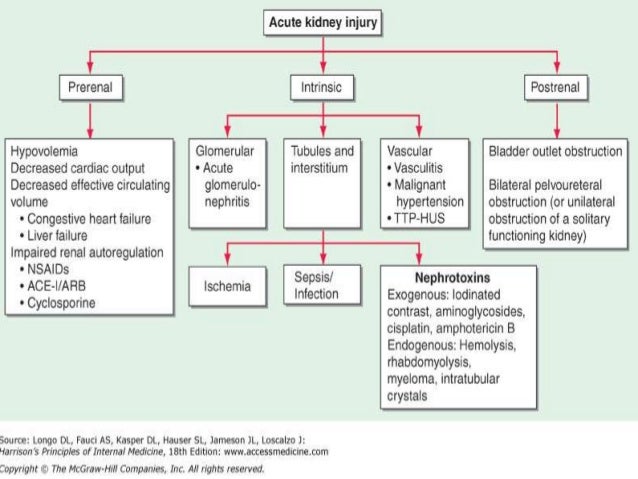Acute renal failure : Definition, Etiopathogenesis, Symptoms, Treatment And MCQs for NEET, GPAT, CSIR NET JRF
INTRODUCTION :-
- Acute renal failure also termed as ARF is a syndrome characterized by rapid onset of renal dysfunction.
- Renal dysfunction represents oliguria and sudden increase in metabolic waste product (urea and creatinine) in the blood with consequent development of uremia.
- Oliguria represents the production of abnormally small amount of urine.
- Anuria represents failure of the kidney to produce urine.
ETIOPATHOGENESIS :-
The causes of acute regal failure may be classified as pre – renal, intra – renal and post – renal in nature :
- Pre – renal cause : These disease refers to the sudden decrease in blood flow towards the nephron. These causes include inadequate cardiac output and hypovolaemia or vascular disease causing reduced perfusion of the kidney.
- Intra – renal cause : It refers to the disease of renal tissue itself. These causes include vascular disease of arteries and arterioles within the kidney, disease of glomeruli, acute tubular necrosis etc.
- Post – renal cause : It is characteristically caused by obstruction to the flow of urine anywhere along the renal tract distal to the opening of the collection duct.
It is important that ARF originating in pre and post renal disease such as by renal ischemia or renal infection, eventually leads to intra renal disease. Thus, a full blown ARF reflects some degree of nephron damage.
SYMPTOMS :-
Some of the symptoms faced by a patient suffering from ARF are as follow :
- Water – electrolyte imbalance.
- Fatigue.
- Insufficient urine production.
- Urinary retention.
- Shortness of breath.
- Swelling.
- Too much acid in blood and tissue.
Pathogenesis

TREATMENT :-
- In case of acute renal failure diuretics are given to the patient as they help to eliminate extra water from the body.
- Certain medical procedures can also be applied like dialysis as this machine clean the blood when the kidneys are no longer to do so.
- Certain devises like ureteral stent are also implanted. It is a thin tube inserted into the muscular duct that carries urine from the kidney to the bladder. Typically, used when the flow of urine is blocked.
- Replacing fluid lost through sweating, bleeding, vomiting or diarrhea to treat or prevent dehydration.
MULTIPLE CHOICE QUESTIONS :-
1.] Production of abnormally small amount of urine is called ?
(a) Oliguria
(b) Anuria
(c) Both (a) and (b)
(d) None of the above
2.] The condition in which kidney is failed to produce urine is called ?
(a) Diabetes
(b) Oliguria
(c) Anuria
(d) All of the above
3.] What does the renal dysfunction represents ?
(a) Oliguria and anuria
(b) Sudden increase in metabolic waste product
(c) Consequent development of uremia
(d) All of the above
4.] Acute renal failure is classified in how many types ?
(a) 2
(b) 3
(c) 4
(d) 5
5.] ARF stands for ?
(a) Acute renal failure
(b) Abnormal renal failure
(c) Acute renal fracture
(d) None of the above
6.] 1. At what rate does the GFR typically decline in males after the age of 45 years?
(a) 0.1 ml/min/1.73 m 2
(b) 0.5 ml/min/1.73 m 2
(c) 0.8 ml/min/1.73 m 2
(d) 1.2 ml/min/1.73 m 2
7.] Which of the following does not form part of the glomerular filtration barrier?
(a) Endothelial cell fenestration
(b) Sub-endothelial space
(c) Glomerular basement membrane
(d) Podocyte foot process slit diaphragm
8.] Which of the following cell types does not perform a phagocytic function?
(a) Glomerular endothelial cell
(b) Mesangial cell
(c) Macrophages
(d) Podocyte
9.] Which of the following statements about angiotensin II is false?
(a) It causes vasoconstriction of the efferent arteriole
(b) It is increased in renal acidosis
(c) It increases aldosterone production
(d) It is reduced in people with diabetes
10.] What are the symptoms of ARF ?
(a) Shortness of breath
(b) Too much acid in blood and tissue
(c) Swelling
(d) All of the above
SOLUTIONS :-
1.] (a) Oliguria
2.] (c) Anuria
3.] (d)
4.] (b) 3
5.] (a) Acute renal failure
6.] (d) 1.2 ml/min/1.73 m 2
7.] (b) Sub-endothelial space
8.] (a) It causes vasoconstriction of the efferent arteriole
9.] (d) It is reduced in people with diabetes
10.] (d)
List of Successful GPATINDIAN CANDIDATES
REFERENCES :-
1.] Textbook Of Pathology By Harsh Mohan; 7th edition; Page no. 641.